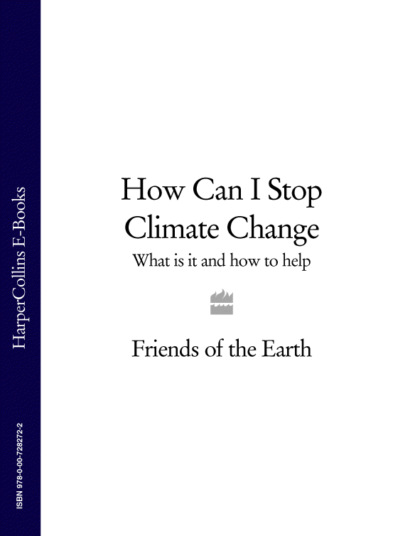По всем вопросам обращайтесь на: info@litportal.ru
(©) 2003-2025.
✖
How Can I Stop Climate Change: What is it and how to help
Настройки чтения
Размер шрифта
Высота строк
Поля
How Can I Stop Climate Change: What is it and how to help
Литагент HarperCollins
Don’t just sit there, do something. But what? How Can I Stop Climate Change? explains what climate change is and what you can do to stop it. Written by the experts at Friends of the Earth, it gives you the facts and figures and offers practical advice and simple solutions.What is happening and why?Learn to distinguish myth from fact and find out what the future holds, based on the scientific evidenceWhat are our options?Discover what works and what doesn’t – using cleaner fuels, saving energy, changing government policiesWhat can you do?Get advice on what you personally can do to make a real difference and help stop climate change
how can i stop
climate change?
Helen Burley and Chris Haslam
contents
Foreword (#u708d756d-1247-585b-a44f-0bc7a4806f58)by Tony Juniper, Friends of the Earth’s Executive (#u708d756d-1247-585b-a44f-0bc7a4806f58)Director (#u708d756d-1247-585b-a44f-0bc7a4806f58)
Chapter 1 (#u5ee5bb2d-6a43-5e8b-93e5-4f7cf570b606)The climate is changing around us (#u5ee5bb2d-6a43-5e8b-93e5-4f7cf570b606)
Chapter 2 (#u966e89ba-4e84-5bb9-9c43-6ea1c2629e7b)The science of climate change (#u966e89ba-4e84-5bb9-9c43-6ea1c2629e7b)
Chapter 3 (#ufecdcbd9-08e5-5682-8a2c-528e39d98372)How much carbon can we live with? (#ufecdcbd9-08e5-5682-8a2c-528e39d98372)
Chapter 4 (#u9bebd0bb-bed2-52d8-af16-3a9603708f03)Saving energy (#u9bebd0bb-bed2-52d8-af16-3a9603708f03)
Chapter 5 (#litres_trial_promo)Using cleaner energy (#litres_trial_promo)
Chapter 6 (#litres_trial_promo)How we can make change happen (#litres_trial_promo)
Chapter 7 (#litres_trial_promo)In the home (#litres_trial_promo)
Chapter 8 (#litres_trial_promo)Out and about (#litres_trial_promo)
Chapter 9 (#litres_trial_promo)Scaling up your impact (#litres_trial_promo)
Chapter 10 (#litres_trial_promo)Resources (#litres_trial_promo)
Find out more (#litres_trial_promo)
Index (#litres_trial_promo)
How to join Friends of the Earth (#litres_trial_promo)
Acknowledgements (#litres_trial_promo)
Copyright (#litres_trial_promo)
About the Publisher (#litres_trial_promo)
foreword (#u7b0d5c0d-3410-57a3-bc01-255b46870878)
“I was recently at the launch of the new high-speed rail link from London to Paris. Passengers boarded at eleven in the morning and arrived right in the heart of Paris just 180 minutes later. As the train slipped through the autumn countryside of southern England and northern France people talked face to face, read the morning papers and ate and drank in comfort and quiet. The people on Eurostar’s Tread Lightly might not have known it but they were also doing the planet a favour. Each passenger going from London to Paris by train is creating just a tenth of the climate-changing emissions of someone making the journey by aeroplane.
For me that day was a moment of inspiration, a reminder of how humanity’s technical brilliance, plus a dose of common sense, can take us - literally - to places we once thought impossible.
This book is about a better life. It’s about turning the challenge of climate change into a way forward for us all, and coming out on the other side healthier, fitter and happier. And because we need to do something now, rather than in 40 years’ time, it’s about making that journey at high speed.
Our starting point is the science - what’s happening to our world and why. The story has been brilliantly told by others, notably by the Nobel prize-winning scientists who make up the Intergovernmental Panel on Climate Change and former US vice-president Al Gore. We explain some key facts - about what’s going on, and what’s likely to happen if we let it (Chapters 1 to 3) - before moving on to the big question: what are we going to do about it?
Imagine a home that you don’t need to heat because the sun does it for you. Imagine your fridge running on the never-ending power of the tides that beat at Britain’s shores. Imagine buses so reliable and clean you actually want to leave the car at home. Imagine the end of fuel poverty, better food, fewer traffic jams and happier neighbourhoods. Imagine a new economic wave, new jobs in new industries supplying whole new markets. All this happens to be possible because the things that we need to do to stop climate change (read about them in Chapters 4 to 9) will also improve our quality of life.
The solutions are out there, but who’s going to make them happen? From fitting low-energy light bulbs, to flying less and recycling more, there are many things each of us can do (lots of practical information in Chapters 7 to 9). Among the green self-help manuals around encouraging each of us to do our bit to take the stress off the planet, few make this key point: that even if each of us were to deal with the environmental impact of our home, our travel and our shopping, it would still not be enough. Yes I can turn off the lights but I don’t run the polluting power station that makes the electricity. I can use my car less but why should I, if some gas guzzler is allowed to take up my space on the road? I can insulate my loft and even install solar panels on my house but what about my neighbour who can’t afford it, and what about my kids’ school, which uses far more energy than my family does?
Most climate-changing pollution is outside my direct control. Greenhouse gases are just part of how things work – like the way food is produced, public institutions are run, our roads are built. I can directly control only about a third of my own tiny share of Britain’s carbon footprint. Someone has got to change the way things work on a big scale - and fast. In fact the science implies that the UK should cut its emissions of the main greenhouse gas, carbon dioxide, by at least 80 per cent by the middle of this century. When you think about how dependent we are now on oil, gas and coal, this looks like a huge task. Who’s going to do it?
As consumers we have a certain amount of muscle – and we should use it. Nagging our shops and services for greener stuff helps to push them in the right direction: being an ethical consumer also tells the politicians that we’re ready for change.
But we’re not just shoppers. Each of us is part of a family, neighbourhood, or town. We can talk to our friends and family, get things done in our clubs, societies, schools, unions, and associations to reduce their carbon footprint.
Most important, we have rights and a voice as citizens. We can tell our elected representatives – from the town hall to parliament – that we want a greener life. They should get on and make it easier for all of us to do the low-carbon thing. Governments can ban cars with poor fuel consumption, set tough standards for products and provide alternatives to flying. Governments can structure markets to make companies innovate: obliging local authorities to specify clean green energy for all new homes, for example, would create a huge business opportunity and, as other countries have shown, do a lot to cut emissions.
But this scale of change will only happen if enough of us ask for it. When I joined the staff of Friends of the Earth in 1990 one of the first things I did was to promote our findings on how halting deforestation would be good for the climate. Since then we have notched up a series of wins for the environment. We have put green issues firmly on the political agenda, sought broad changes to the way our economy works and persuaded politicians to take real steps to protect our communities and future generations. And we’ve always done it with strong public backing: the reason you have doorstep recycling is because thousands of people like you asked for it.
At about the time this book will first appear in the shops a new Climate Change Act will be passing into UK law. This will be the world’s first legally binding national framework for long-term reductions in greenhouse gas emissions. If the government has done its job properly the law will set a target for cutting carbon dioxide emissions by 80 per cent by 2050, including emissions from aviation and shipping. Friends of the Earth’s Big Ask campaign and the voices of hundreds of thousands of people have been crucial in securing this breakthrough. It shows how powerful we are when we act together. In all my years working on the environment I have never been so excited about the changes that we’re about to see – changes that people like you have made possible. There’s a lot do, but we are making real progress.
The book in your hands is one of the next steps. It is the perfect companion for making the most of the opportunity created by the new Climate Change Act. The solutions are out there. Get on board and make them live.
None of us can deal with climate change alone - we have to act together. How can I stop climate change? I can’t. But we can.
Tony Juniper, Executive Director, Friends of the Earth, 2002–08.
FRIENDS OF THEEARTH
“The honest answer to the question ‘How can I stop climate change?’ is ‘I can’t. But we can.’”
Executive director,Tony Juniper
chapter 1 (#u7b0d5c0d-3410-57a3-bc01-255b46870878)
the climate is changing around us (#u7b0d5c0d-3410-57a3-bc01-255b46870878)
Flood, drought, storm, heatwave.
What’s happening to the weather?
a warmer world
Even without the scientists telling us, we can all see a newpattern emerging: freaky weather, unusual temperatures,ice sheets crashing into the sea, migrating birds turningup ahead of schedule, plants flowering early…
From the UK and Europe to Australia and theAmericas, this chapter offers some snapshots of the wayour planet is changing around – and because of – us.
The graph below showsthe global temperature foreach year from 1850 to2006. Climate experts use14 °C as a reference point.The wavy line reveals theunmistakeable trend –that the world has beengetting hotter over thepast 150 years.
Литагент HarperCollins
Don’t just sit there, do something. But what? How Can I Stop Climate Change? explains what climate change is and what you can do to stop it. Written by the experts at Friends of the Earth, it gives you the facts and figures and offers practical advice and simple solutions.What is happening and why?Learn to distinguish myth from fact and find out what the future holds, based on the scientific evidenceWhat are our options?Discover what works and what doesn’t – using cleaner fuels, saving energy, changing government policiesWhat can you do?Get advice on what you personally can do to make a real difference and help stop climate change
how can i stop
climate change?
Helen Burley and Chris Haslam
contents
Foreword (#u708d756d-1247-585b-a44f-0bc7a4806f58)by Tony Juniper, Friends of the Earth’s Executive (#u708d756d-1247-585b-a44f-0bc7a4806f58)Director (#u708d756d-1247-585b-a44f-0bc7a4806f58)
Chapter 1 (#u5ee5bb2d-6a43-5e8b-93e5-4f7cf570b606)The climate is changing around us (#u5ee5bb2d-6a43-5e8b-93e5-4f7cf570b606)
Chapter 2 (#u966e89ba-4e84-5bb9-9c43-6ea1c2629e7b)The science of climate change (#u966e89ba-4e84-5bb9-9c43-6ea1c2629e7b)
Chapter 3 (#ufecdcbd9-08e5-5682-8a2c-528e39d98372)How much carbon can we live with? (#ufecdcbd9-08e5-5682-8a2c-528e39d98372)
Chapter 4 (#u9bebd0bb-bed2-52d8-af16-3a9603708f03)Saving energy (#u9bebd0bb-bed2-52d8-af16-3a9603708f03)
Chapter 5 (#litres_trial_promo)Using cleaner energy (#litres_trial_promo)
Chapter 6 (#litres_trial_promo)How we can make change happen (#litres_trial_promo)
Chapter 7 (#litres_trial_promo)In the home (#litres_trial_promo)
Chapter 8 (#litres_trial_promo)Out and about (#litres_trial_promo)
Chapter 9 (#litres_trial_promo)Scaling up your impact (#litres_trial_promo)
Chapter 10 (#litres_trial_promo)Resources (#litres_trial_promo)
Find out more (#litres_trial_promo)
Index (#litres_trial_promo)
How to join Friends of the Earth (#litres_trial_promo)
Acknowledgements (#litres_trial_promo)
Copyright (#litres_trial_promo)
About the Publisher (#litres_trial_promo)
foreword (#u7b0d5c0d-3410-57a3-bc01-255b46870878)
“I was recently at the launch of the new high-speed rail link from London to Paris. Passengers boarded at eleven in the morning and arrived right in the heart of Paris just 180 minutes later. As the train slipped through the autumn countryside of southern England and northern France people talked face to face, read the morning papers and ate and drank in comfort and quiet. The people on Eurostar’s Tread Lightly might not have known it but they were also doing the planet a favour. Each passenger going from London to Paris by train is creating just a tenth of the climate-changing emissions of someone making the journey by aeroplane.
For me that day was a moment of inspiration, a reminder of how humanity’s technical brilliance, plus a dose of common sense, can take us - literally - to places we once thought impossible.
This book is about a better life. It’s about turning the challenge of climate change into a way forward for us all, and coming out on the other side healthier, fitter and happier. And because we need to do something now, rather than in 40 years’ time, it’s about making that journey at high speed.
Our starting point is the science - what’s happening to our world and why. The story has been brilliantly told by others, notably by the Nobel prize-winning scientists who make up the Intergovernmental Panel on Climate Change and former US vice-president Al Gore. We explain some key facts - about what’s going on, and what’s likely to happen if we let it (Chapters 1 to 3) - before moving on to the big question: what are we going to do about it?
Imagine a home that you don’t need to heat because the sun does it for you. Imagine your fridge running on the never-ending power of the tides that beat at Britain’s shores. Imagine buses so reliable and clean you actually want to leave the car at home. Imagine the end of fuel poverty, better food, fewer traffic jams and happier neighbourhoods. Imagine a new economic wave, new jobs in new industries supplying whole new markets. All this happens to be possible because the things that we need to do to stop climate change (read about them in Chapters 4 to 9) will also improve our quality of life.
The solutions are out there, but who’s going to make them happen? From fitting low-energy light bulbs, to flying less and recycling more, there are many things each of us can do (lots of practical information in Chapters 7 to 9). Among the green self-help manuals around encouraging each of us to do our bit to take the stress off the planet, few make this key point: that even if each of us were to deal with the environmental impact of our home, our travel and our shopping, it would still not be enough. Yes I can turn off the lights but I don’t run the polluting power station that makes the electricity. I can use my car less but why should I, if some gas guzzler is allowed to take up my space on the road? I can insulate my loft and even install solar panels on my house but what about my neighbour who can’t afford it, and what about my kids’ school, which uses far more energy than my family does?
Most climate-changing pollution is outside my direct control. Greenhouse gases are just part of how things work – like the way food is produced, public institutions are run, our roads are built. I can directly control only about a third of my own tiny share of Britain’s carbon footprint. Someone has got to change the way things work on a big scale - and fast. In fact the science implies that the UK should cut its emissions of the main greenhouse gas, carbon dioxide, by at least 80 per cent by the middle of this century. When you think about how dependent we are now on oil, gas and coal, this looks like a huge task. Who’s going to do it?
As consumers we have a certain amount of muscle – and we should use it. Nagging our shops and services for greener stuff helps to push them in the right direction: being an ethical consumer also tells the politicians that we’re ready for change.
But we’re not just shoppers. Each of us is part of a family, neighbourhood, or town. We can talk to our friends and family, get things done in our clubs, societies, schools, unions, and associations to reduce their carbon footprint.
Most important, we have rights and a voice as citizens. We can tell our elected representatives – from the town hall to parliament – that we want a greener life. They should get on and make it easier for all of us to do the low-carbon thing. Governments can ban cars with poor fuel consumption, set tough standards for products and provide alternatives to flying. Governments can structure markets to make companies innovate: obliging local authorities to specify clean green energy for all new homes, for example, would create a huge business opportunity and, as other countries have shown, do a lot to cut emissions.
But this scale of change will only happen if enough of us ask for it. When I joined the staff of Friends of the Earth in 1990 one of the first things I did was to promote our findings on how halting deforestation would be good for the climate. Since then we have notched up a series of wins for the environment. We have put green issues firmly on the political agenda, sought broad changes to the way our economy works and persuaded politicians to take real steps to protect our communities and future generations. And we’ve always done it with strong public backing: the reason you have doorstep recycling is because thousands of people like you asked for it.
At about the time this book will first appear in the shops a new Climate Change Act will be passing into UK law. This will be the world’s first legally binding national framework for long-term reductions in greenhouse gas emissions. If the government has done its job properly the law will set a target for cutting carbon dioxide emissions by 80 per cent by 2050, including emissions from aviation and shipping. Friends of the Earth’s Big Ask campaign and the voices of hundreds of thousands of people have been crucial in securing this breakthrough. It shows how powerful we are when we act together. In all my years working on the environment I have never been so excited about the changes that we’re about to see – changes that people like you have made possible. There’s a lot do, but we are making real progress.
The book in your hands is one of the next steps. It is the perfect companion for making the most of the opportunity created by the new Climate Change Act. The solutions are out there. Get on board and make them live.
None of us can deal with climate change alone - we have to act together. How can I stop climate change? I can’t. But we can.
Tony Juniper, Executive Director, Friends of the Earth, 2002–08.
FRIENDS OF THEEARTH
“The honest answer to the question ‘How can I stop climate change?’ is ‘I can’t. But we can.’”
Executive director,Tony Juniper
chapter 1 (#u7b0d5c0d-3410-57a3-bc01-255b46870878)
the climate is changing around us (#u7b0d5c0d-3410-57a3-bc01-255b46870878)
Flood, drought, storm, heatwave.
What’s happening to the weather?
a warmer world
Even without the scientists telling us, we can all see a newpattern emerging: freaky weather, unusual temperatures,ice sheets crashing into the sea, migrating birds turningup ahead of schedule, plants flowering early…
From the UK and Europe to Australia and theAmericas, this chapter offers some snapshots of the wayour planet is changing around – and because of – us.
The graph below showsthe global temperature foreach year from 1850 to2006. Climate experts use14 °C as a reference point.The wavy line reveals theunmistakeable trend –that the world has beengetting hotter over thepast 150 years.











